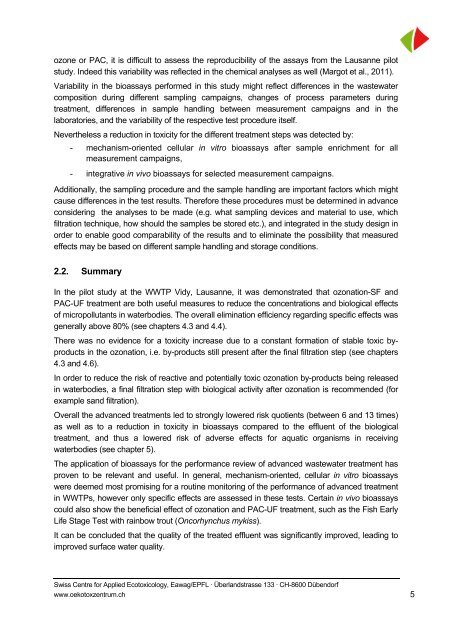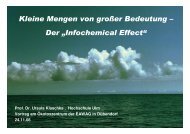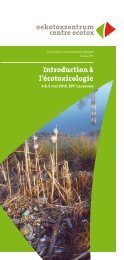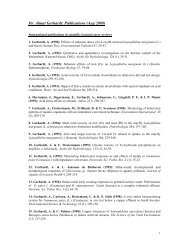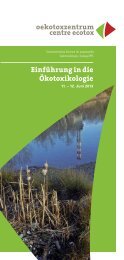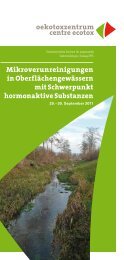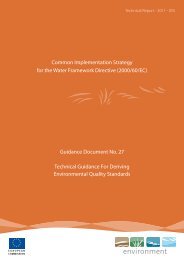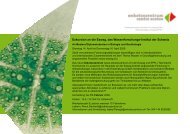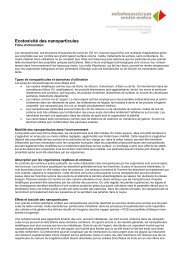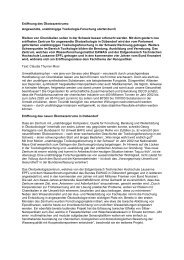Evaluation of Bioassays and Wastewater Quality ... - Oekotoxzentrum
Evaluation of Bioassays and Wastewater Quality ... - Oekotoxzentrum
Evaluation of Bioassays and Wastewater Quality ... - Oekotoxzentrum
You also want an ePaper? Increase the reach of your titles
YUMPU automatically turns print PDFs into web optimized ePapers that Google loves.
ozone or PAC, it is difficult to assess the reproducibility <strong>of</strong> the assays from the Lausanne pilot<br />
study. Indeed this variability was reflected in the chemical analyses as well (Margot et al., 2011).<br />
Variability in the bioassays performed in this study might reflect differences in the wastewater<br />
composition during different sampling campaigns, changes <strong>of</strong> process parameters during<br />
treatment, differences in sample h<strong>and</strong>ling between measurement campaigns <strong>and</strong> in the<br />
laboratories, <strong>and</strong> the variability <strong>of</strong> the respective test procedure itself.<br />
Nevertheless a reduction in toxicity for the different treatment steps was detected by:<br />
- mechanism-oriented cellular in vitro bioassays after sample enrichment for all<br />
measurement campaigns,<br />
- integrative in vivo bioassays for selected measurement campaigns.<br />
Additionally, the sampling procedure <strong>and</strong> the sample h<strong>and</strong>ling are important factors which might<br />
cause differences in the test results. Therefore these procedures must be determined in advance<br />
considering the analyses to be made (e.g. what sampling devices <strong>and</strong> material to use, which<br />
filtration technique, how should the samples be stored etc.), <strong>and</strong> integrated in the study design in<br />
order to enable good comparability <strong>of</strong> the results <strong>and</strong> to eliminate the possibility that measured<br />
effects may be based on different sample h<strong>and</strong>ling <strong>and</strong> storage conditions.<br />
2.2. Summary<br />
In the pilot study at the WWTP Vidy, Lausanne, it was demonstrated that ozonation-SF <strong>and</strong><br />
PAC-UF treatment are both useful measures to reduce the concentrations <strong>and</strong> biological effects<br />
<strong>of</strong> micropollutants in waterbodies. The overall elimination efficiency regarding specific effects was<br />
generally above 80% (see chapters 4.3 <strong>and</strong> 4.4).<br />
There was no evidence for a toxicity increase due to a constant formation <strong>of</strong> stable toxic byproducts<br />
in the ozonation, i.e. by-products still present after the final filtration step (see chapters<br />
4.3 <strong>and</strong> 4.6).<br />
In order to reduce the risk <strong>of</strong> reactive <strong>and</strong> potentially toxic ozonation by-products being released<br />
in waterbodies, a final filtration step with biological activity after ozonation is recommended (for<br />
example s<strong>and</strong> filtration).<br />
Overall the advanced treatments led to strongly lowered risk quotients (between 6 <strong>and</strong> 13 times)<br />
as well as to a reduction in toxicity in bioassays compared to the effluent <strong>of</strong> the biological<br />
treatment, <strong>and</strong> thus a lowered risk <strong>of</strong> adverse effects for aquatic organisms in receiving<br />
waterbodies (see chapter 5).<br />
The application <strong>of</strong> bioassays for the performance review <strong>of</strong> advanced wastewater treatment has<br />
proven to be relevant <strong>and</strong> useful. In general, mechanism-oriented, cellular in vitro bioassays<br />
were deemed most promising for a routine monitoring <strong>of</strong> the performance <strong>of</strong> advanced treatment<br />
in WWTPs, however only specific effects are assessed in these tests. Certain in vivo bioassays<br />
could also show the beneficial effect <strong>of</strong> ozonation <strong>and</strong> PAC-UF treatment, such as the Fish Early<br />
Life Stage Test with rainbow trout (Oncorhynchus mykiss).<br />
It can be concluded that the quality <strong>of</strong> the treated effluent was significantly improved, leading to<br />
improved surface water quality.<br />
Swiss Centre for Applied Ecotoxicology, Eawag/EPFL · Überl<strong>and</strong>strasse 133 · CH-8600 Dübendorf<br />
www.oekotoxzentrum.ch<br />
5


